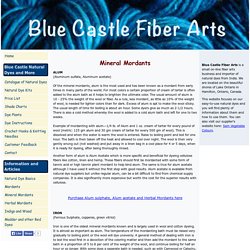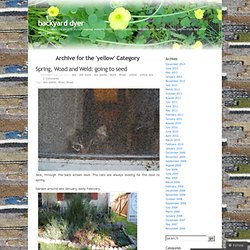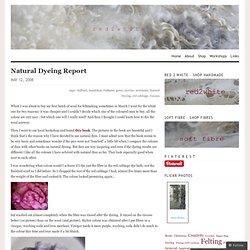Zoom
Trash

Leslie Fox
Interested in Weaving & Dyeing
Mineral Mordants for Natural Dyes. ALUM(Aluminum sulfate, Aluminum acetate) Of the mineral mordants, alum is the most used and has been known as a mordant from early times in many parts of the world.

For most colors a certain proportion of cream of tartar is often added to the alum bath as it helps to brighten the ultimate color. The usual amount of alum is 10 - 25% the weight of the wool or fiber. As a rule, less mordant, as little as 10% of the weight of wool, is needed for lighter colors than for dark. Excess of alum is apt to make the wool sticky.
Information, news and supplies for hand spinning. Come in and look around. Ply Magazine. Yellow « backyard dyer. Hibiscus Rose Mallow (Hibiscus spp.) on Wool, scoured but no pre-mordant or pre-Alum.

Far left, Hibiscus with a pinch of copper after-bath. Middle, dried Hibiscus flowers mashed (in the dye pot while simmering, before adding the wool) to yield a darker color. On the right wool and soy-silk simmered conventionally with dried Hibiscus. Other fibers – like silk – will probably get different results – but this is what I got dying wool. Again, the wool samples were not pre-mordanted. One well might ask why more yellow. Next, I’m trying to find local plants that don’t require strong chemical mordants. Copper after-bath on the far left could have been accomplished with an Indigo over-dye, otherwise the rest of the tests were done without mordanting (copper, tin, chrome, etc.) Lastly, Hibiscus is easily available in Los Angeles, southern California, and works dried or fresh. Natural Dyeing Report « Red 2 White. When I was about to buy my first batch of wool for feltmaking sometimes in March I went for the white one for two reasons: it was cheaper and I couldn’t decide which one of the coloured ones to buy, all the colour are very nice - but which one will I really need?

And then I thought I could learn how to dye the wool anyway. Then I went to our local bookshop and found this book. The pictures in the book are beautiful and I think that’s the reason why I have decided to use natural dyes. I must admit now that the book seems to be very basic and sometimes wonder if the pics were not “touched” a little bit when I compare the colours of dyes with other books on natural dyeing.
Dyeing « Frog in the pond. Colours from our backyard September 22, 2010 at 11:55 am (Dyeing, textiles) These are the results of my eucalyptus and brown onion skin dyeing.

From top to bottom: eucalyptus overdyed with 50/50 eucalyptus & brown onion skin; eucalyptus overdyed with 100% brown onion skin; eucalyptus only. Natural Dyes. Making Natural Dyes from Plants. Did you know that a great source for natural dyes can be found right in your own back yard!

Roots, nuts and flowers are just a few common natural ways to get many colors. Yellow, orange, blue, red, green, brown and grey are available. Go ahead, experiment! Gathering plant material for dyeing: Blossoms should be in full bloom, berries ripe and nuts mature. Remember, never gather more than 2/3 of a stand of anything in the wild when gathering plant stuff for dying. To make the dye solution: Chop plant material into small pieces and place in a pot. Getting the fabric ready for the dye bath: You will have to soak the fabric in a color fixative before the dye process. How to Dye Fabric Pink Naturally - Cherries. Echoes of a Dream: Natural dyeing. A beginners guide.............. Gulp....A number of people have asked me questions about this dyeing lark and I thought maybe I ought to do a post (another one I hear you mutter) in a tutorial sort of way.

I hesitate because I'm no expert but just a mad woman who got hooked over the summer. So what I would like to do is share some of the knowldge I've accumulated, the suppliers I've used (sorry no web link to Mother Nature yet) and to tell you about the colours I got. First off, a WARNING. Natural dyeing is highly addictive. You will never look at a plant in the same way again and your friends and neighbours will start locking their garden gates. The Raw Materials. Echoes of a Dream: Natural dyeing. A beginners guide..............
Mordants - Surfactant - Soda and more. Natural Dye Mordant; Fiber and Yarn Preparation for Natural Dye. These natural dye mordant and wash instructions are focused on wools and silk since they dye the best with natural dyes.

If dyeing cellulose fibers, please pay close attention to additional notes. For more information on natural dye mordants please see this mordant page Important note: Weigh the amount of yarn or fiber you plan to dye before making it wet. Amount of mordant and dyestuff to use is based on a percentage of the dry weight of your material. Washing Wash your fibers/yarns even if they look really clean. Dharma Trading carries Synthrapol, a well-known soap for fibers.